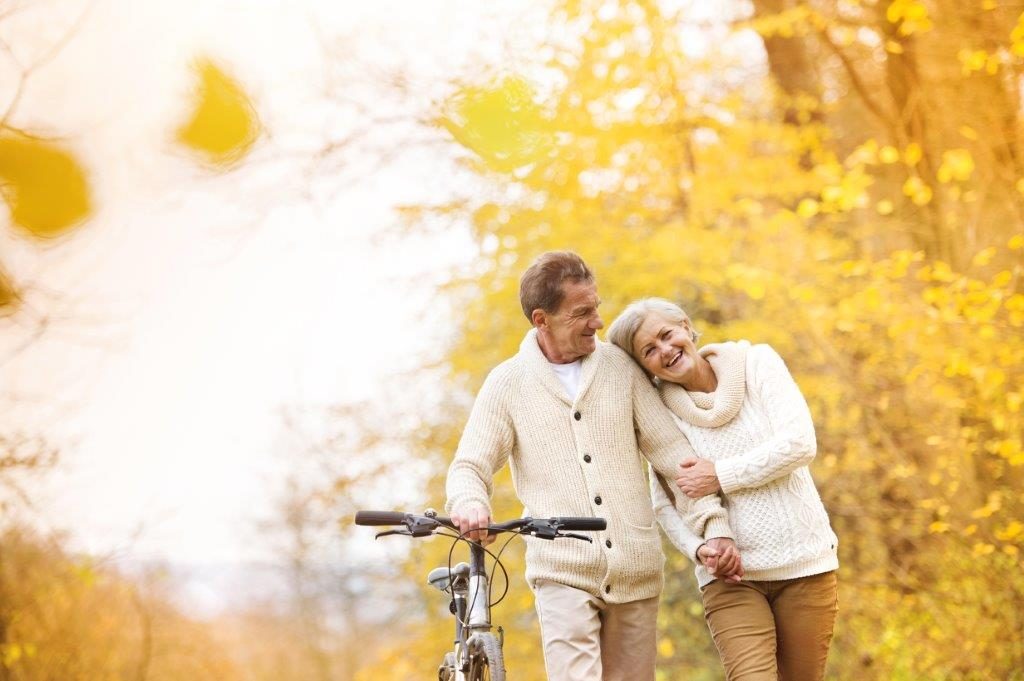
Active couple that is aging in place are enjoying each other’s company outdoors while experiencing the beauty of the fall season
Many of us look forward to the changing seasons – for instance, the first snowfall in the winter, the colorful leaves and the harvest in the fall, the new growth of leaves and flowers in the spring, and the long days and outdoor activities of the summer. Of course, there are many other characteristics of the four principal seasons that appeal to us and that we look forward to experiencing.
One thing that the seasons do for us is dividing the year into quarters – even those places that don’t have strong evidence of each season such as those with very short summers or those with mild winters. Those four quarters help us mark the passage of time, and after a while, we realize that several of them have come and gone. We think about the previous fall, or the one before that, or the one five or ten years ago when there was something remarkable or noteworthy about the season of our lives at that time. Otherwise, we reflect on the fall or the winter (or another season) and realize just how many of them have come and gone.
Nevertheless, we look forward to each coming season for various reasons. The springtime has the leaves budding, the birds returning, the flowers blooming, the fresh breezes, the days getting a little bit longer, a little warmer weather, and the chance to air out the house after being closed up all winter. In the summertime, we take vacations, we get by with less clothing and no jackets, the days are long, the temperatures are hot, we play baseball and partake in swimming and other water sports, we go boating and play golf (although neither one is strictly limited to the summertime), and we have plenty of other outdoor activities such as hikes and cookouts.
In the fall, we look forward to the temperatures cooling a bit, to the leaves changing color and adding a beautiful setting to the landscape, to fall sports such as football, to campfires, and to the coming holidays. Then the winter caps off the year with the arrival of the holidays and all of the decorations and cooking and baking that accompany them, the colder weather that is a huge contrast to the other seasons, outdoor sports that can only be done in the winter, staying inside with a fire in the fireplace, relatively short daylight periods, and the outlook for the coming spring. Then, we repeat the seasons.
When we think of aging in place, in addition to just remaining at home and experiencing the changing of the seasons year-after-year, there are safety and functional considerations.
Fall leaves can hide hoses, toys, dog bones, yard tools, divots, uneven walkway surfaces, and other things in and about the yard that normally we would notice to avoid. As pretty as the fallen leaves are with the patterns they form and the colors they provide, they can be slippery.
In the winter, there can be patches of ice that form on driveways and sidewalks or even on grass and leaves that can develop a slipperiness. There can be a lot of glare that happens when the sun strikes snow-covered or icy surfaces. We may move a little slower as well due to a general slowing in our movements with age, because we are wearing heavier clothing that may weigh us down or hinder our movements, and to be as sure-footed as possible on potentially slippery footing.
In the summer, there can be more glare that we are used to experiencing at other times of the year due to the intensity of the sun. Vision issues and limitations compound this. We also are more prone to overexposure of the sun and to sunburn or skin irritation issues.
The springtime is a transitional season with both warm days and throwback cold ones. There can be a lot of mud from spring rains and the thawing of wintertime frozen conditions. We may not always be dressed appropriately for the conditions – too few or too many clothes.
Let’s not forget that our pets experience the seasons in different ways also – on their own and with us.
As great as it is to look forward to their arrival, to experience them while they are here, and to look back fondly upon the various seasons of the years and what they may have meant to our lives, there are safety concerns that we need to keep in mind as aging in place professionals – and that people of any age, but especially seniors, should be aware of to get the most enjoyment from each season. Being injured or sidelined from attempting to experience the season unsafely will not do any of us any good.
The seasons are fun to experience and they help us define the passage of time. For some people, the seasons are fun and joyous and are eagerly anticipated. For others, they may be quite emotional in another way – especially when a loss is associated with that time of year. This is another dimension of aging in place and how people relate to the space, their surroundings, and what they are facing.
